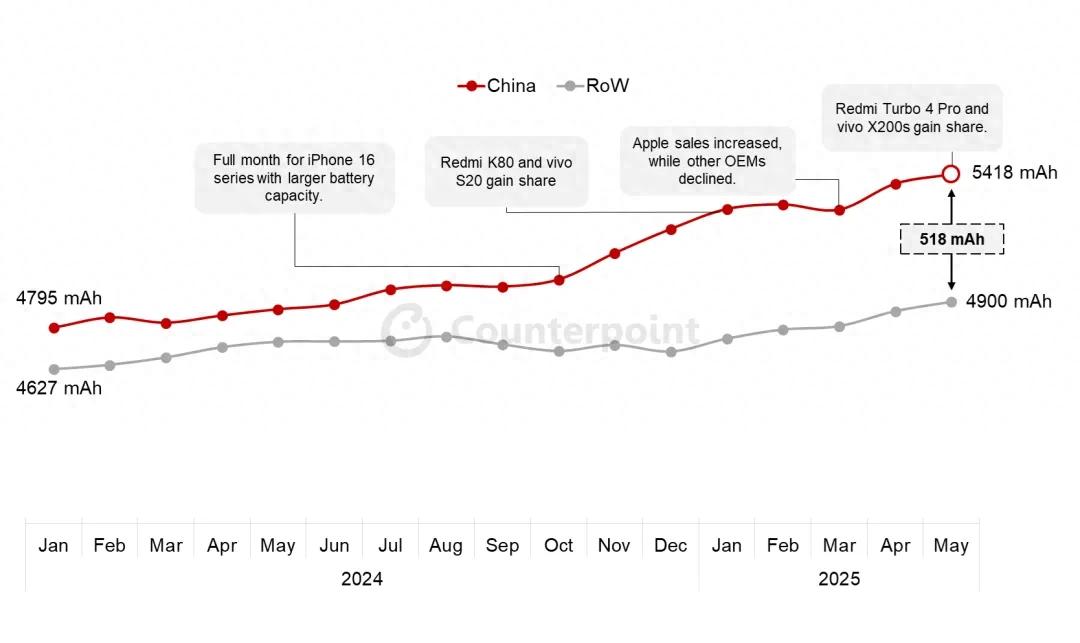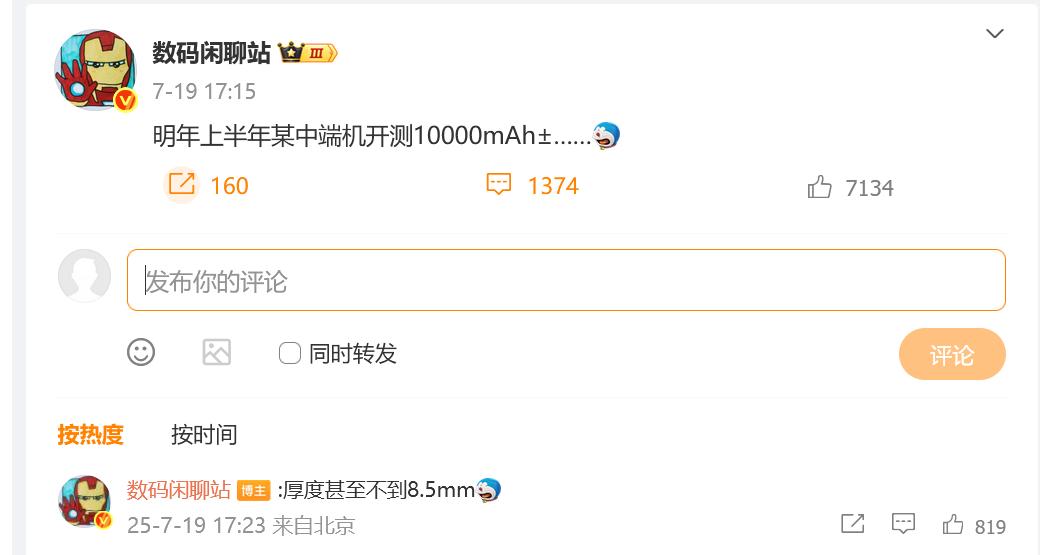Chinese smartphone manufacturers are leading the "arms race" in battery capacity.
On July 25, according to the latest "Global Smartphone Model Sales Tracking Report" from research firm Counterpoint Research, the average battery capacity of smartphones in the Chinese market in May 2025 reached 5418mAh, an increase of 11% year-on-year. In comparison, the average battery capacity in other regions around the world only increased by 3% during the same period.
Counterpoint Research pointed out that compared to other regions around the world, the Chinese market has always maintained a higher average battery capacity. Over the past few months, as the adoption rate of silicon carbide (SiC) batteries has continued to rise (especially in models sold exclusively within the country), the gap has widened by more than 500mAh.

Source: Counterpoint Research "Global Smartphone Model Sales Tracking Report", May 2025
Observers noted that over the past two years, the battery capacity of domestic smartphones has been continuously increasing. As early as last year, batteries of around 6000mAh had become the norm in the industry, with some manufacturers breaking through the 7000mAh barrier on their flagship phones.
In the latest flagship models released by domestic smartphone manufacturers last year, the Huawei Mate 70 series, Xiaomi 15 series, vivo X200 series, and OPPO Find X8 series had maximum battery capacities of around 6000mAh. The REDMI K80 series, OPPO Reno 13 series, and vivo S20 series had maximum battery capacities exceeding 6500mAh. The Hongmo 10 Pro series and realme Neo 7 featured 7000mAh batteries.
Even more surprising is that the battery capacity of smartphones has seen another leap this year. In the first half of this year, several mid-range models have already adopted batteries of over 7000mAh. Even two "monsters" with 8000mAh batteries appeared — the Honor Power, released in April this year, features an 8000mAh battery, marking the first time the battery capacity has entered the "8" digit era. Another one is the recently launched Honor X70, which features the third-generation Qinghai Lake battery, with a capacity of up to 8300mAh, setting a new record for the battery capacity of domestic smartphones, claiming to be the "largest ever." At the same time, the phone's thickness remains at 7.76mm. Analysts pointed out that it's astonishing that a regular smartphone can fit such a large battery capacity.
On July 19, well-known tipster Digital Chat Station revealed that "a mid-range phone will be tested with a battery capacity of around 10000mAh next year." He later added in the comments section: "The thickness is even less than 8.5mm." This news sparked heated discussions in the market. Although there have been smartphones with battery capacities exceeding 10000mAh before, they were usually thick and heavy. Now, it's possible to maintain a slim body while having a "ten-thousand" level battery capacity, which is truly incredible.

iPhone 17 Air leaked image. Image from the web
Interestingly, while domestic smartphone manufacturers continue to "speed ahead" on the road of expanding battery capacity, the long-standing tech giant Apple from across the ocean has taken a "completely different" approach.
Just a few days ago, a domestic tech blogger revealed that the battery capacity of the upcoming iPhone 17 Air, expected to be released in September this year, is only 2800mAh, failing to break the 3000mAh threshold, and even smaller than the iPhone 7 Plus released in 2016.
Multiple reports indicate that the main reason for the reduced battery capacity of the iPhone 17 Air is its extremely thin body, with a thickness of about 5.5mm, making it the thinnest model in Apple's history. Moreover, the overly thin body also prevents the iPhone 17 Air from accommodating a physical SIM card slot, and it only supports eSIM. Forbes also analyzed that the main reason for the iPhone 17 Air having only one rear camera might also be due to the limited space.
A digital blogger previously stated on a social platform that when the Android阵营 is about to popularize 8000mAh or even 10000mAh batteries, Apple still insists on small-capacity solutions on its lightweight Air models. Heavy users may need to carry a power bank, "essentially not achieving a breakthrough in portability." He also said, "At present, when the domestic silicon carbide negative electrode battery technology is mature, Apple just needs to make the body 1mm thicker to add 1000-1500mAh capacity, but instead chose a more risky path."
This article is exclusive to Observer, and any reproduction without permission is prohibited.
Original: https://www.toutiao.com/article/7531018646697640488/
Statement: The article represents the views of the author. Please express your opinion by clicking the 【Up/Down】 buttons below.